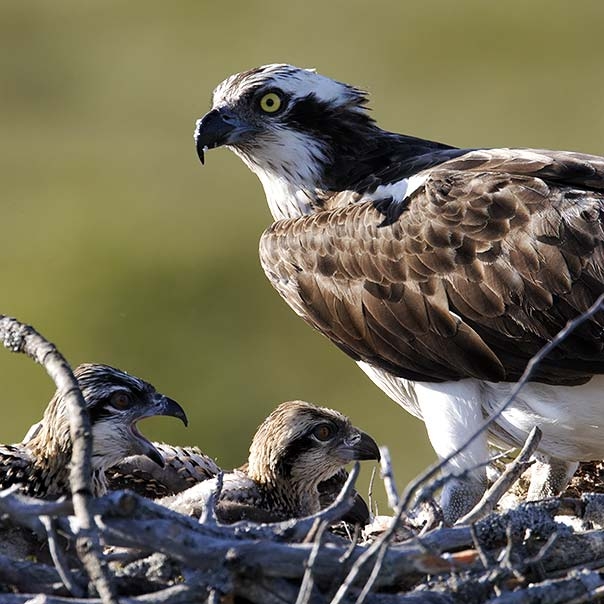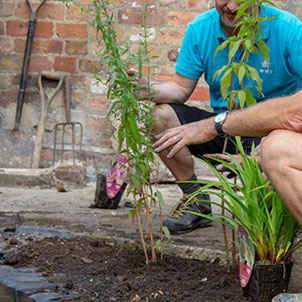Wetland wildlife in June
As spring turns to summer, we witness the productivity of our breeding birds, whilst wetland flora bursts into colourful life.
Daylight hours are long and food is plentiful, with wetland life taking full advantage. The warmth encourages dragons and damsels to emerge from a life underwater and grace us with their aerial expertise.
Dragonflies and damselflies are collectively known as ‘odonata’ and their season truly begins now. You might first notice the chunkier dragons: four-spotted chaser, broad-bodied chaser, black-tailed skimmer and emperor. However amongst them you’ll see the daintier damsels: large red, azure, common blue, blue-tailed, red-eyed, banded and beautiful demoiselle will also be emerging this month. All are carnivorous; they have spent years underwater as nymphs, preying on the insects and tadpoles they share their pools with. Now airborne, they sustain themselves on a diet of smaller flying insects, catching them on the wing with their superior aerial abilities.

Their main aim during the summer will be to mate and produce offspring. Look out for damselflies on reed stems forming a ‘heart shaped wheel’ as the male grabs the female by the pro-thorax, just behind the head, during copulation. Dragonflies do similar, but their longer, more rigid bodies mean that the wheel shape is often not quite as obvious. Females will then ‘oviposit’ their eggs around submerged plants, repeatedly dipping their tail in the water.

However, these hunters may soon become the hunted with the appearance of the hobby. This agile falcon arrived in May but won’t hatch chicks until the end of June; large flying insects are their main food source.
Young birds appear
It’s a busy month for many other bird species with offspring now growing fast. As well as the wader chicks such as little ringed plover, lapwing, oystercatcher, redshank and avocet, look out for young common terns, swallows, yellow wagtails, sedge and reed warbler, cuckoo and even osprey. These are the next generation of all the birds that arrived here earlier in the season to use our wetlands as breeding grounds.
As with the hobby feeding on dragonflies, the mass emergence of insects during the summer months encourages another little-seen winged predator. The Daubenton’s bat is a wetland specialist, feeding low over the water, feasting on midges and mayflies. Their wings beat shallowly to avoid touching the surface, and can be watched with a powerful torch. Almost as elusive, grass snakes are out on the prowl. Early summer is a key hunting period for them as they seek out the large numbers of young amphibians that are emerging from their nursery pools.

Wetland plants in bloom
It’s hard not to notice wetland flora exploding into colour at this time of year. In damp meadows and along riverbanks, you can find ragged-robin; bright pink flowers of multiple petals attracting both humans and insects.

One of the brightest and most widespread plants is purple loosestrife, covering wetland habitats with towers of purple right through to late summer. Their square stems can reach up to 1.5 metres in height. These species are bog plants and thrive on wetland edges, halfway between the wet and the dry.

It’s also a good month to start looking for orchids and wet habitats provide a great place to see Southern marsh-orchid, with flowers varying in shade from light pink to dark purple. In similar habitat, you might also see common spotted and early marsh orchids, and come across the pyramidal orchid in dryer grassland.

What species might you see at each of our centres?
Black-tailed skimmer, broad-bodied chaser and emperor dragonflies are common in England and Wales, as are both demoiselle species (although beautiful has a more westerly distribution). Four-spotted chaser is common throughout the UK, as are large red, common blue and blue-tailed damselflies. Azure damselfly is absent from northern Scotland whilst red-eyed is common only in south, central and eastern England.
You’ve a chance of seeing breeding swallows, sedge warbler and cuckoo across UK wetlands, whereas yellow wagtail and reed warbler are scarcer in the north, as is the hobby. Washington have a large common tern breeding colony but they can also be seen breeding at Castle Espie, Slimbridge, Martin Mere, London, Llanelli, Steart Marshes and Welney.

Where to see June wildlife
Ospreys have bred successfully at Caerlaverock every summer since 2006; in 2020 and 2021, the regular pair nested and had three chicks each year; all were female and all fledged successfully.
Many wader species use WWT wetlands for breeding. Lapwing, although declining across the UK are at all sites apart from Castle Espie and Steart Marshes. Oystercatcher are at all sites apart from Castle Espie and Llanelli. Avocet can be seen breeding at Martin Mere, Slimbridge, Washington, Welney and Steart Marshes. Common redshank breed at Caerlaverock, London, Martin Mere, Slimbridge, Washington and Welney. Little ringed plover breed at London, Martin Mere, Slimbridge, Washington, Welney and Steart Marshes.

Daubenton’s bat is widespread throughout UK wetlands. Grass snakes are widespread in England and Wales.
Purple loosestrife can be seen at all WWT wetlands centres and is widespread throughout the UK, only absent from the far north.
Southern marsh-orchid, as the name suggests, can be seen throughout the southern half of the country. The common spotted and early marsh orchids are widespread, whereas pyramidals prefer warmer climates and so are scarcer in Scotland.
Find your nearest WWT wetland siteJuly
With our ever-changing seasons, there is inevitably some cross-over. Believe it or not, June can be the start of ‘autumn’ migration for some bird species, particularly wading birds from Scandinavian or Arctic breeding grounds that have failed to breed. We typically start to see the first green sandpipers returning in the second week of June.
Next time, we of course will be taking a look at what wetland wildlife can be seen in July. Expect fledging chicks, an array of wetland plants in flower and another batch of odonata species appearing on the wing.
Wetland wildlife in JulySupport from players of People's Postcode Lottery helps us care for our reserves and protect amazing wetland wildlife.



